11 Best Native Plants for the Pacific Northwest
BY LASHONDA TUCKER | MAY 27TH, 2023 | LAWN CARE, PACIFIC NORTHWESTFrom the Oregon Coast to the Olympic National Park, the Pacific Northwest (PNW) has many places you can visit to take in the natural, organic beauty of native plants and wildlife. Falling in love with the diverse flora of the area can leave you wanting more. That’s why we’ve compiled a list of the best native plants for the Pacific Northwest. You can create a smaller version of a diverse plant culture in your yard.
This article allows you to invite as much of the Pacific Northwest’s native roots into your yard as you’d like. We’ve identified shrubs, wildflowers, perennials, and other native vegetation you can place in flower beds, plant as groundcovers or lawn specimens, or use in any way you prefer.
- 11 Best Native Plants for Your Pacific Northwest Yard
- How to Choose Native Plants for Your Pacific Northwest Landscape
- FAQ About Native Pacific Northwest Plants
- Where to Find Native Plants in Pacific Northwest
11 Best Native Plants for Your Pacific Northwest Yard
1. Red Flowering Currant (Ribes sanguineum)
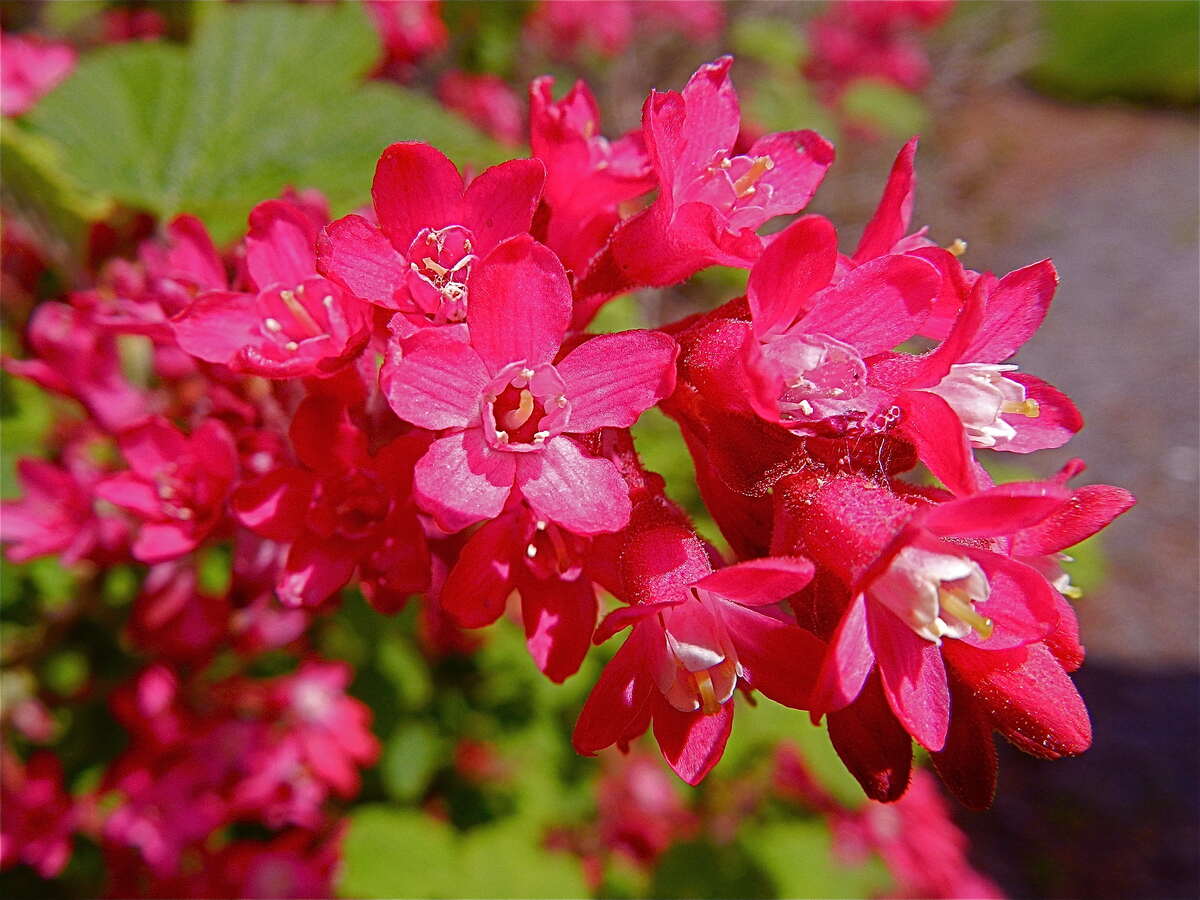
Photo Credit: Peter Stevens / Flickr / CC BY 2.0
Although this shrub’s edible berries have been accused of being insipid, they have been used to make juice, pies, syrup, and wine. Birds and mammals, like deer, squirrels, and foxes, also like the taste of the fruit. If you don’t mind sharing, red flowering currant is a good choice for your home.
This shrub also attracts butterflies and hummingbirds. They won’t fight with the mammals or you over the fruit, because the pollinators and birds are drawn to the showy, drooping pinkish-red flowers.
This edible plant is low-maintenance. She thrives best in well-drained, rocky soil, but also tolerates poor soil. This shrub grows in both full sun and partial shade.
Once red flowering currant, also called blood currant, is established, she is drought tolerant. Start her off with plenty of water in her first one to two seasons.
Plant red flowering currant as hedges or in a wildlife garden. She’ll also do well in rain gardens and xeriscape landscapes.
Native Regions: All
Plant type: Deciduous shrub
Hardiness zones: 5 to 9
Sun: Full sun, partial shade
Soil: Prefers well-drained, rocky soil but tolerates poor soil
Duration: Perennial
Fragrance: Sweet sage-rosemary
Bloom time: Spring
Water needs: Water the first two summers of establishment
Mature height: 8-10 feet
Maintenance: Low
2. Western Columbine (Aquilegia formosa)
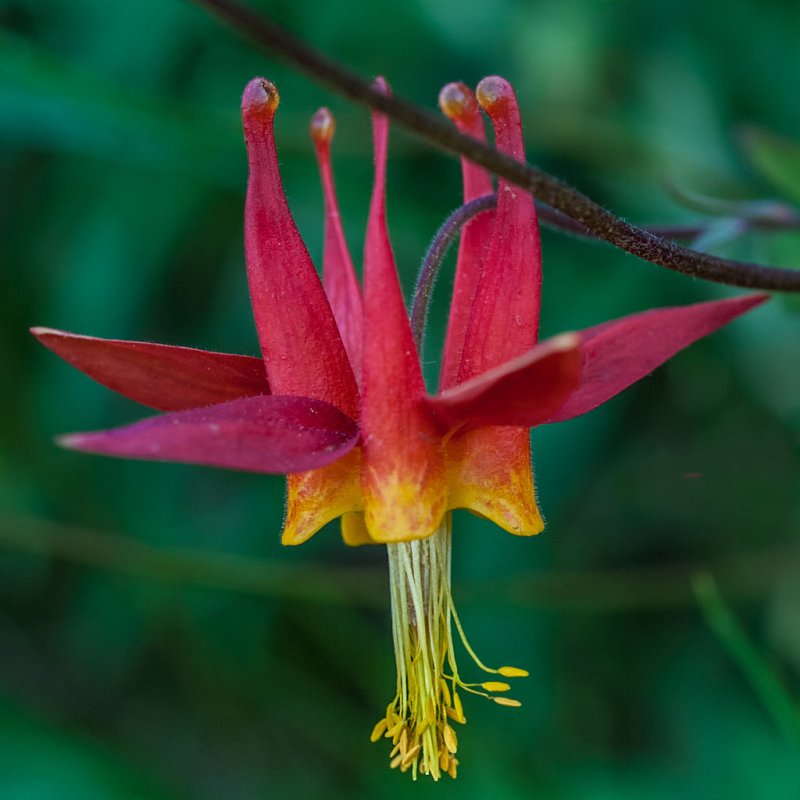
Photo Credit: Franco Folini from San Francisco, USA / Wikimedia Commons / CC BY-SA 2.0
Western columbine is great for a softer touch to your home garden. She has delicate-looking red and yellow flowers that flare outward at the bottom. But beware: columbine is not as innocent as she seems. She contains a toxin that can cause stomach issues and heart palpitations.
Western columbine will only last about two to three years. However, she proliferates by self-seeding. Hummingbirds and butterflies enjoy the blossoms that sprout in late spring to early summer.
This plant is commonly found in moist areas, like woodlands and forests. She grows well in a variety of soil types, just as long as the soil drains well. Columbine prefers the shade but will work with full sun if she is kept moist. She is easy to grow and works well in shade gardens and borders.
Native Regions: All
Plant type: Flower
USDA Hardiness Zone: 3 to 9
Sun: Full sun or partial shade (preferably)
Soil: Chalky, clay, loamy, or sandy soil that’s well-drained and nutrient-rich
Duration: Perennial
Fragrance: N/A
Bloom time: Late spring to early summer
Water needs: Average
Mature height: 1 to 3 feet
Potential hazards: Contain toxin that can cause stomach issues or heart palpitations
Maintenance: Low; deadhead fading blooms and cut back in mid-summer
3. Red-Osier Dogwood (Cornus sericea)
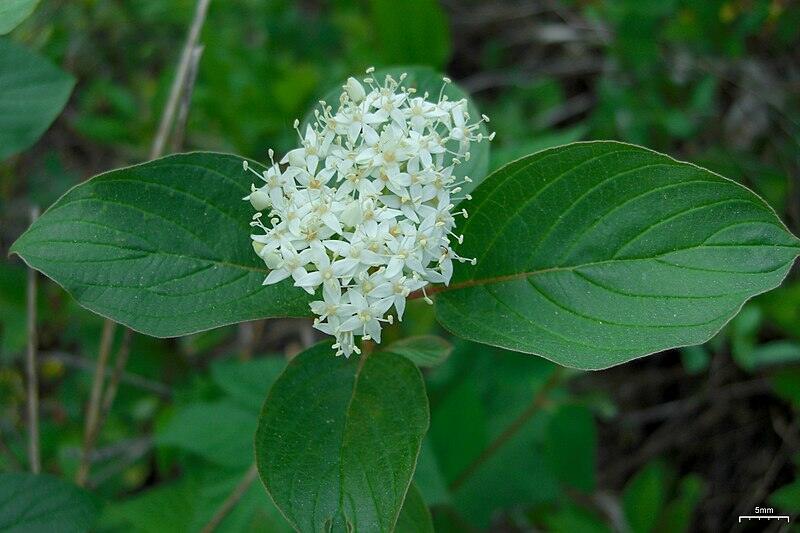
Photo Credit: Jason Hollinger / Wikimedia Commons / CC BY 2.0
Red-osier dogwood is also known as red twig dogwood. She distinguishes herself with stems that are a bright red in the fall and winter. The spring brings a cluster of white flowers, which turn to white berries in the summer. Pollinators and butterflies are attracted to the flowers, while birds satisfy their hunger with the berries.
Red-osier grows quickly, but you can root prune this plant to control her size. This shrub is a good candidate for movement because she transplants successfully.
If you like to see color in the winter, red-osier will make great shrub borders.
Native regions: All
Plant type: Shrub
Hardiness zones: 2 to 7
Sun: Full sun to partial shade
Soil: Chalk, clay, loam, sand, moist, adaptable to a wide range of soils.
Duration: Perennial
Bloom time: Spring and summer
Water needs: Medium to high
Mature height: 6 to 9 feet
Maintenance: Medium. Use a spade to root prune if you want to stop her from vigorously spreading. Prune in early spring to encourage new stem growth.
4. Tall Oregon Grape (Mahonia aquifolium)
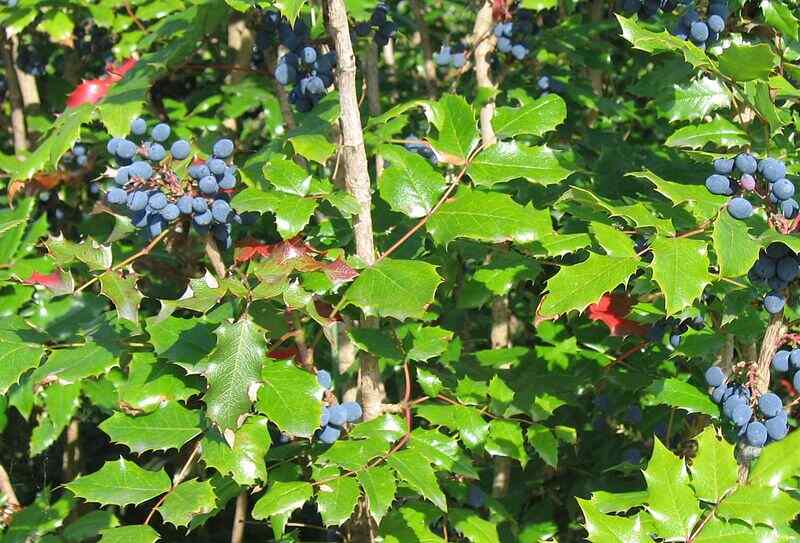
Photo Credit: The original uploader was Meggar at English Wikipedia. / Wikimedia Commons / CC BY-SA 3.0
Tall Oregon grape, also called holly-leaved barberry, is an excellent choice for homes with small children or pets. Unlike western columbine, tall Oregon grape is non-toxic and has been used for its medicinal properties. It is both anti-inflammatory and antibacterial.
The flowers emerge bright and yellow in the spring. The blue-colored berries, which resemble grapes, arrive in the summer. Pollinators are attracted to the cluster of showy petals, while birds and wildlife get a mouthful of the purplish berries.
Tall Oregon grape thrives in partial to full shade. This shrub makes a tasty hedge or addition to woodland and shade gardens.
Native regions: All
Plant type: Shrub
Hardiness zones: 5 to 8
Sun: Partial shade to full shade
Soil: Loam, acidic, well-drained
Duration: Perennial
Fragrance: Honey
Bloom time: Spring
Water needs: Medium
Mature height: 6 to 8 feet
Maintenance: Low
5. Common Camas (Camassia quamash)
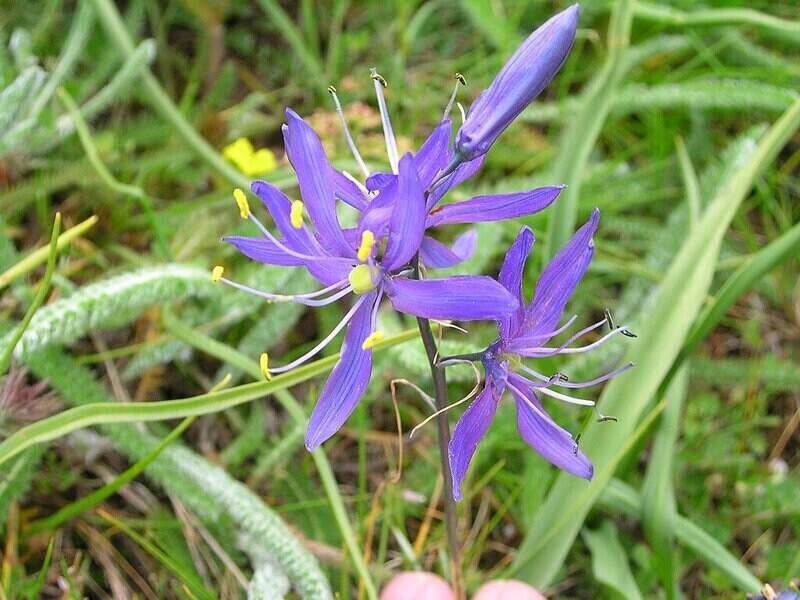
Photo Credit: brewbooks from near Seattle, USA / Wikimedia Commons / CC BY-SA 2.0
Common camas could be mistaken for grass, except for the beautiful light blue flowers that grow atop the long grass-like blades. The petals blossom from late spring to early summer. Common camas has low to medium maintenance requirements, and she is highly pest and disease resistant.
She thrives best when planted in the fall and when she receives full sun. Camas adapts to partial shade, but will only grow a percentage of her potential in shady conditions.
She works well planted in groups. Add color to beds and borders with common camas, or by using this wildflower as underplantings for shrubs and roses.
Native regions: All
Plant type: Flowering plant/wildflower
Hardiness zones: 3 to 8
Sun: Full sun, very little shade
Soil: High organic matter with good drainage; tolerates seasonally moist soil
Duration: Perennial
Fragrance: Spicy; Smells like molasses when boiled
Bloom time: Late spring to early summer
Water needs: Average (Natively found in moist, spring meadows that dry by late spring)
Mature height: Up to 30 inches
Maintenance: Low to medium
6. Pacific Red Elderberry (Sambucus racemosa)
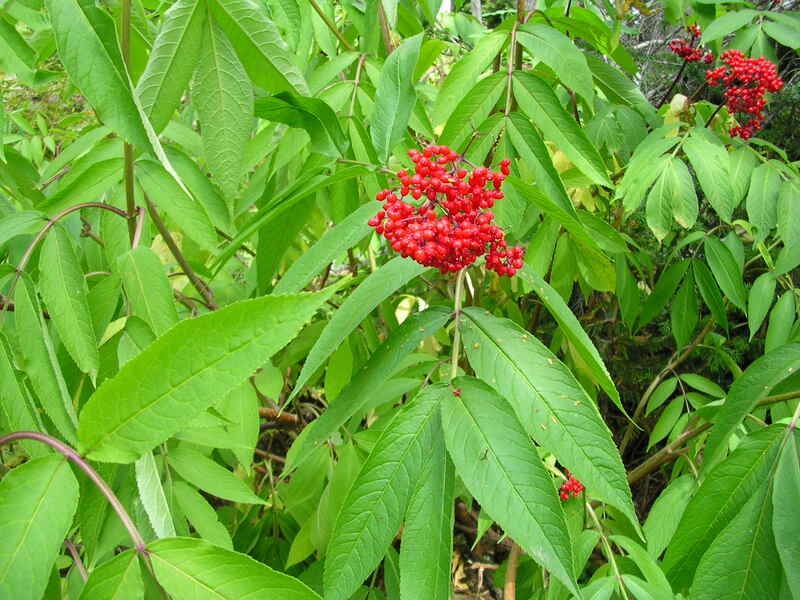
Photo Credit: brewbooks / Flickr / CC BY-SA 2.0
If you’re looking for a plant that brings color during the fall, pacific red elderberry is for you. She blooms a cluster of white flowers in late spring to early summer. The berries emerge in the fall bringing both nourishment for birds and autumn color. As tasty as the fruit may look, be mindful that the berries are toxic when uncooked.
Pacific red elderberry grows naturally in moist woodlands and stream banks. She is accustomed to moist soil and is a great choice to plant next to a creek. This shrub also works well in borders and beds. Just make sure she gets enough sun or she will not grow to her fullest potential.
Native regions: All
Plant type: Shrub
Hardiness zones: 3 to 9
Sun: Partial shade
Soil: Well-drained, loamy
Duration: Deciduous
Fragrance: Skunk smell
Bloom time: March – July
Water needs: Medium
Mature height: 3 to 10 feet in a garden (up to 18 feet in the wild)
Potential hazards: The seeds are poisonous, and the raw berries may cause nausea, vomiting, and diarrhea.
Maintenance: Medium; prune to contain the spread
7. Serviceberry (Amelanchier alnifolia)
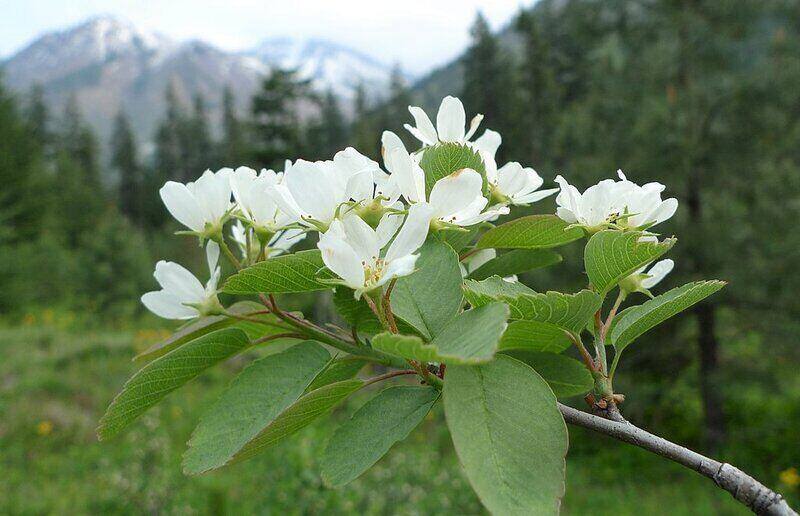
Photo Credit: Thayne Tuason / Wikimedia Commons / CC BY-SA 4.0
Serviceberry is another plant that offers homeowners tasty treats. The berries have been used to make jellies and jams and for medicinal purposes.
White flowers blossom in mid-spring and attract pollinators. Birds come for the berries. Serviceberry will grow in full sun or partial shade. To make sure she sprouts her tasty berries, plant her where she will receive lots of sunlight.
Serviceberry does well in pollinator gardens and, of course, edible gardens.
Native regions: All
Plant type: Shrub
USDA Hardiness Zone: 4 to 9
Sun: Full sun or partial shade
Soil: Loamy or sandy; well-drained
Duration: Perennial
Fragrance: Lightly scented
Bloom time: Spring and summer
Water needs: Low
Mature height: 3 to 16 feet
Maintenance: Low
8. Oceanspray (Holodiscus discolor)
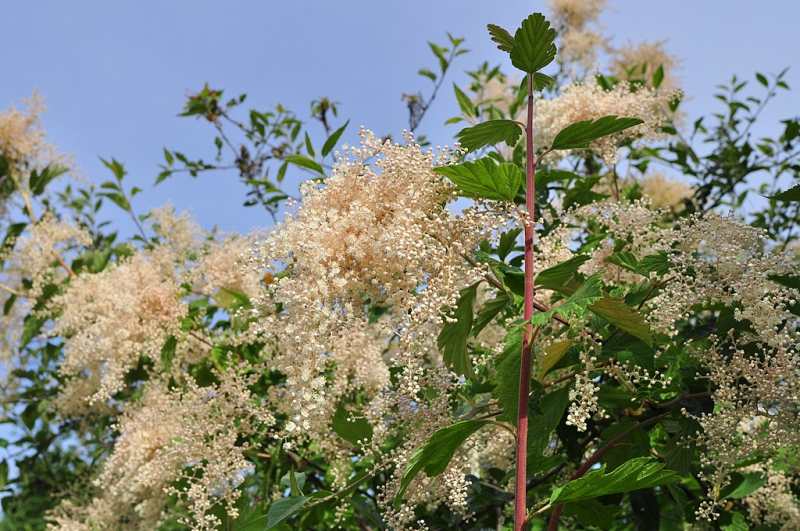
Photo Credit: Joe Mabel / Wikimedia Commons / CC BY-SA 4.0
Oceanspray has green leaves that are hairy on one side. The small petaled white flowers bloom from late spring to late summer. Oceanspray bears fruit that often remains into the fall and winter. Bees and hummingbirds enjoy this shrub, which can grow as tall as 20 feet.
Oceanspray is a good choice for all three states in the Pacific Northwest. This plant is adaptable to multiple soil types. She is also drought-tolerant, making her ideal for the PNW areas that are prone to seasonal desert-like conditions.
Oceanspray is pest- and disease-resistant and requires little pruning. If you’re looking for a low-maintenance shrub, oceanspray will fit well in your cottage or coastal garden.
Native regions: All
Plant type: Shrub
Hardiness zones: 6 to 9
Sun: Full sun to partial sun
Soil: Loam, chalk, clay, sand, well-drained, dry to moist
Duration: Perennial
Fragrance: Sweet and sugary
Bloom time: June – August
Water needs: Low to Medium
Mature height: 3 to 10 feet tall, but can reach heights up to 20 feet
Maintenance: Low
9. Lewis’ Mock Orange (Philadelphus lewisii Pursh)
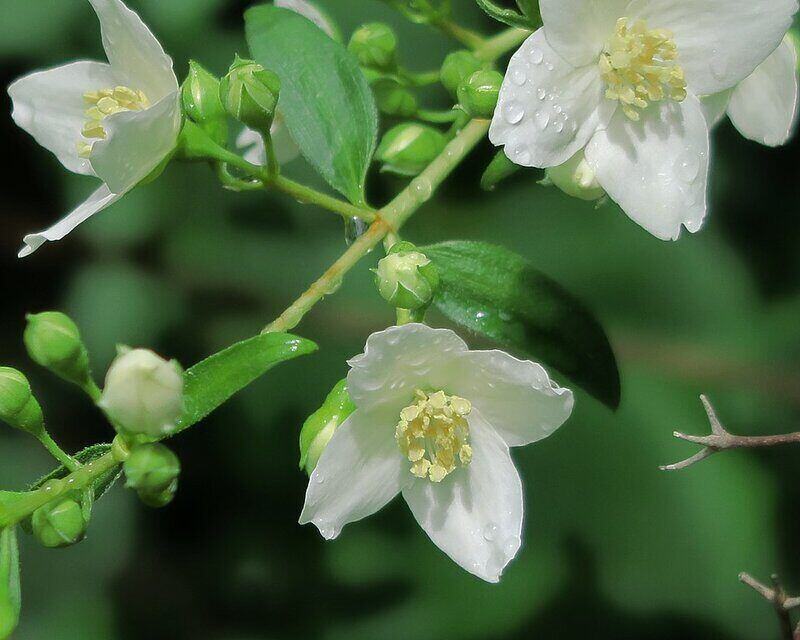
Photo Credit: John Rusk from Berkeley, CA, United States of America / Wikimedia Commons / CC BY 2.0
Lewis’ mock orange is also referred to as wild mock orange, named for the sweet scent that is similar to orange blossoms. This shrub bears white flowers in the spring and summer. You’ll not only give back to the ecosystem because mock orange attracts butterflies, but this sweet-smelling plant is also a shelter for wildlife.
A property with full sun or partial shade will give this plant a thriving environment. Although rich soils are her preference, mock orange adapts to a variety of soil types. She has a fibrous root system that helps prevent erosion.
Plant mock orange in borders, hedges, and low-maintenance landscaping designs.
Native regions: All
Plant type: Shrub
Hardiness zones: 4 to 8
Sun: Full sun, partial shade
Soil: Prefers gravelly and nutrient-rich soils, but tolerates a variety of soil types, like chalk, loam, and sand
Duration: Deciduous
Fragrance: Orangey scent
Bloom time: Spring and summer
Water needs: Low-medium
Mature height: 5 to 8 feet
Potential hazards: Toxic to cats
Maintenance: Low
10. Common Yarrow (Achillea millefolium)
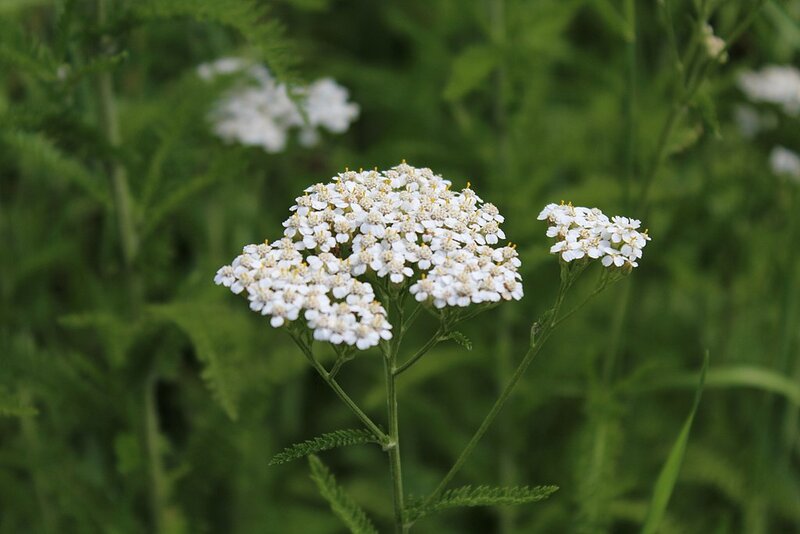
Photo Credit: Jitaeri / Wikimedia Commons / CC BY-SA 4.0
Common yarrow boasts clusters of tiny petaled white flowers. She attracts pollinators but is toxic to pets. She can cause skin irritation and increased photosensitivity if touched, so yarrow is another plant to keep out of the reach of small children. It may seem ironic, but this plant has also been used for medicinal purposes to treat stomach aches, rashes, and fevers.
She is low-maintenance and although she prefers moist soil that is well-drained, she tolerates multiple soil types. You will see a lot of her if you plant her in flower or garden beds, as she is prone to spread aggressively. If you’re looking for a flowering groundcover to replace some turfgrass, common yarrow is a good choice.
Native regions: All
Plant Type: Wildflower
USDA Hardiness Zone: 3 to 9
Sun: Full sun
Soil: Moist but well-drained, all soil types
Duration: Perennial
Fragrance: Pine
Bloom Time/Season of Interest: Late spring, summer
Water Needs: Low
Mature Height: 1 to 3 feet
Potential Hazards: Toxic to cats, dogs, and horses if ingested; for humans, may cause skin irritation or increase photosensitivity if touched
Maintenance Needs: Low
11. Evergreen Huckleberry (Vaccinium ovatum)
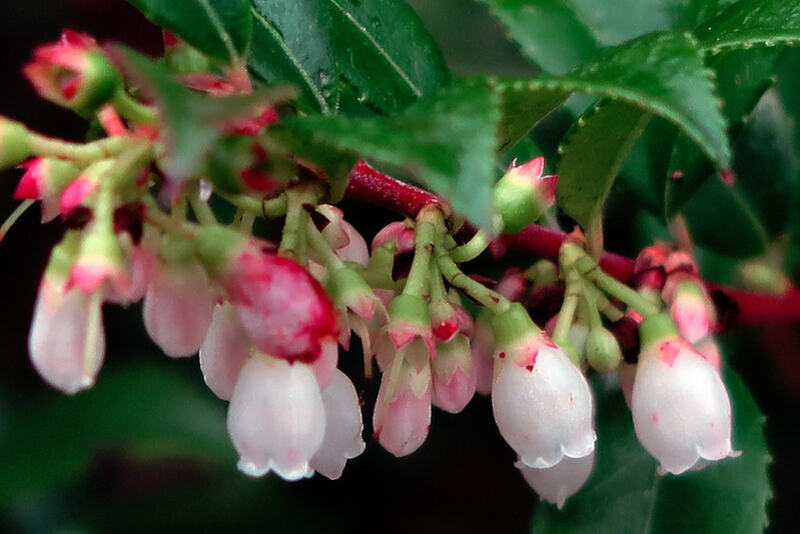
Photo Credit: John Rusk / Flickr / CC BY 2.0
Evergreen huckleberry has edible berries that grow in the summer. With this evergreen, you can feed the wildlife and birds that nibble on the fruit. The berries have been used to make pies and jellies.
This shrub is an attractive display, with her white flowers and reddish leaves appearing in the spring. She thrives best in full sun or part shade.
While she tolerates yards with trees blocking the sunlight, she may not bear flowers or fruit if she is planted in full shade. On the other hand, huckleberry grows tallest in the shade. In the sun she may reach 3 feet; in the shade, she may tower at heights up to 10 feet.
Looking for some ingredients for jam or syrup and a plant for your xeriscape design? This shrub is drought-resistant, so she’ll fit in well. Huckleberry is also an excellent choice for hedges and rain gardens or planted next to patios.
Native regions: Washington and Oregon; not native to Idaho
Plant type: Needled Evergreen shrub
Hardiness zones: 7 to 9
Sun: Sun or shade; prefers partial or full shade
Soil: Tolerates sand, clay, and soils low in organic content; requires acidic soil
Duration: Perennial
Fragrance: Musky
Bloom time: Feb – July
Water needs: Low, Medium to wet
Mature height: 2 to 10 feet tall; grows taller in shade
Maintenance: High
How to Choose Native Plants for Your Pacific Northwest Yard
Choose plants in your area’s USDA hardiness zone. Hardiness zones help gardeners know which plants will survive their area’s coldest winter temperatures. It will still take work to maintain the plants, but because the plants have adapted to the area, they will need less fertilizing, watering, and other upkeep tasks than non-native plants.
Knowing your soil type, how well it drains, and how much sun or shade your yard receives helps you choose plants that are well-suited for your home. Select plants that your yard’s size can accommodate. For example, a small property is probably not a good fit for a Douglas fir tree, which grows very large.
It is also a good idea to choose plants that have a maintenance schedule that matches your availability to care for them. Likewise, select plants that fit your family’s composition. Be mindful of vegetation with hazard precautions if you have small children or pets.
FAQ About Native Pacific Northwest Plants
Seattle’s best native plants include:
• Pacific Bleeding Heart
• Vine Maple
• Wild Ginger
• Salal
• Evergreen Huckleberry
Here are some of the best native plants for Washington:
• Velvet Lupine
• Sagebrush
• Western Columbine
• Vine Maple
• Salal
• Indian Plum
These are some native plants best for the state of Idaho:
• Golden Currant
• Woods’ Rose
• Rose Spirea
• Roundleaf Snowberry
Oregon’s best native plants include:
• Western Bleeding Heart
• Salal
• Vine Maple
• Pacific Beach Strawberry
Native plants are beneficial to the environment in many ways, including reducing pollutants that enter the water supply and sustaining the ecosystem. Growing native plants can also reduce your workload by decreasing the time you spend maintaining them. Here are some advantages of using native plants:
• Adaptability and low maintenance: Native plants are adapted to the local environment, including soil conditions and climate, so they are more likely to thrive with less watering and fertilizing. Once native plants are established, in addition to needing less watering and fertilizing, they typically require less maintenance overall.
• Higher tolerance and cleaner water: Native plants generally have a higher tolerance for local diseases and pests, requiring fewer pesticides, herbicides, and other chemical treatments. This means fewer harmful substances run off into the water.
• Biodiversity: Native plants sustain biodiversity and support the local ecosystem by providing food sources and habitat to pollinators, insects, and wildlife.
Where to Find Native Plants in Pacific Northwest
With all of the parks, waterfronts, and outdoor scenery across the Pacific Northwest, you have more than likely seen a diverse array of native plants. To find vegetation for your home, King County has plant guides and other information that can help you identify flora in the Washington and PNW area. Oregon State University is another resource for native plants in the PNW area.
Now that you have the resources you need for your native plant oasis, make sure you have a lawn that is lush and healthy, too. Contact a lawn care pro near you to do the mowing, edging, and trimming so you can spend more time enjoying the waterfall at Multnomah Falls.
Main Photo Credit: The Oregon Garden / Travel Salem / Flickr / CC BY-ND 2.0